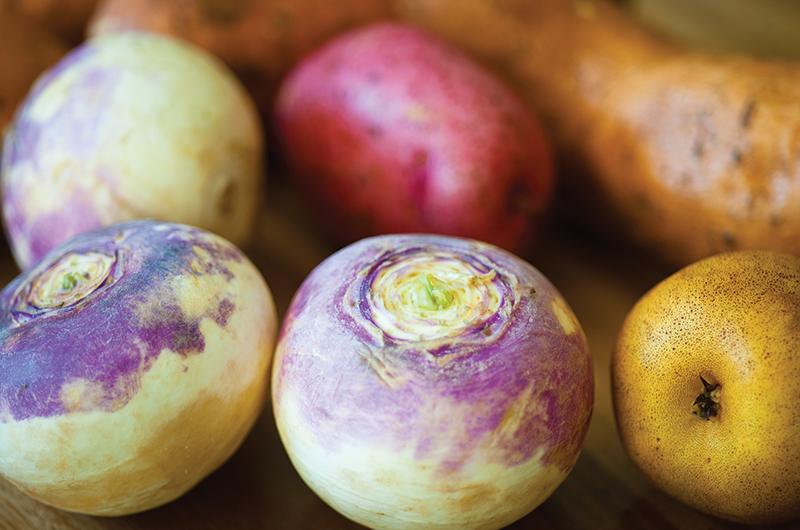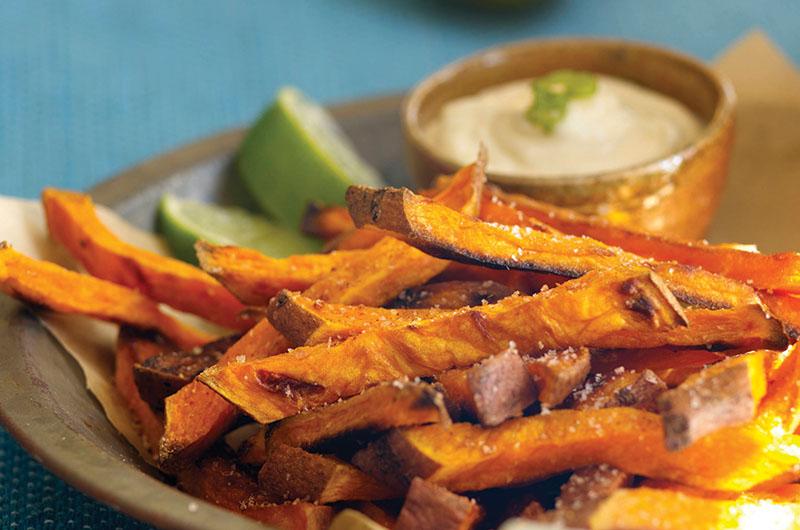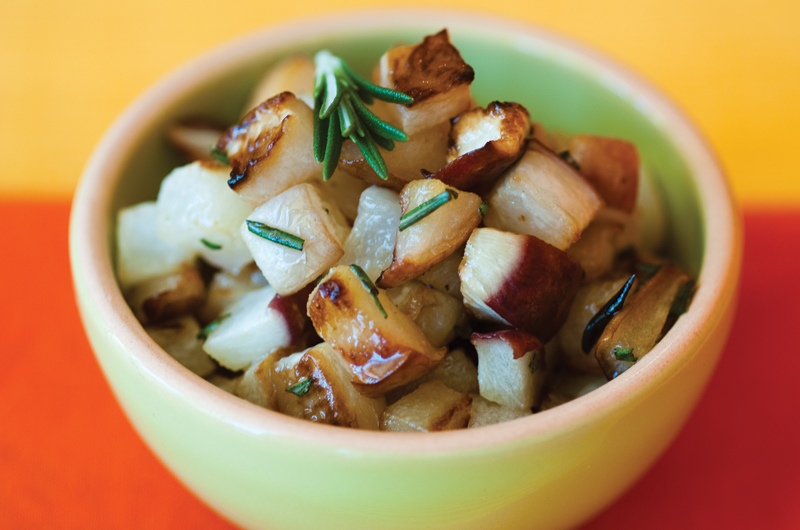“Roast it, and they will eat it” is the introduction to the chapter on roasting vegetables in Susie Middleton’s popular new cookbook, Fast, Fresh & Green (Chronicle Books, April 2010). As we head into winter, the West Tisbury writer’s roasting techniques can help turn some strange-looking, unwieldy vegetables such as rutabagas, turnips, and winter squash into delectable vegetable side dishes.
“The high heat of the oven really brings the sugar out in the vegetables,” Susie explains. “I think they’re a great entry point for people who maybe don’t think they like vegetables or are a little intimidated by cooking vegetables.” Since the vegetables turn sweeter in this process, she adds: “For moms trying to get kids to eat more veggies, roasting is the way to go.”
Helping people better appreciate and enjoy vegetables is a driving goal for this former Fine Cooking magazine editor turned cookbook author. Arriving in my kitchen, carrying a pink-handled knife, Susie comes ready to roast and share her tips. I’m hoping to improve on my own roasting techniques. I love the ease of roasting, but sometimes I find it frustrating with either burned or under-cooked results.
Susie starts with her sweet potato “mini fries” – a recipe for which she’s probably gotten the most positive feedback (after her quick-roasted nearly caramelized tomatoes) since Fast, Fresh & Green came out last spring. Cut like traditional French fries and roasted for twenty minutes at a high temperature, these fries are deliciously sweet – and a lot healthier than regular fries. A lime dipping sauce and a spiced salt finish the dish (see recipe that follows).
Susie says she came to know the magic of high heat at her first restaurant job at Al Forno, the Providence restaurant renowned for its innovative approach to cooking with wood-fired ovens and grills. “I learned there to appreciate fresh ingredients and appreciate what high-heat cooking does to vegetables.” These temperatures make quicker work of cooking dense root vegetables like turnips or beets, but also work surprisingly well for vegetables like broccoli and cauliflower, which get lightly brown and crispy. “They taste like candy,” she says. She created two dipping sauces to accompany a roasted broccoli dish but says people often end up eating them straight from the cooking sheet.
For quick-roasting, she sets the oven temperature at 450 to 475 degrees and finds this temperature works for a variety of vegetables. She suggests purchasing one or two heavy-duty sheet pans, which help keep the vegetables from burning. (A glass Pyrex dish, I learned, doesn’t work as well because the sides hold in the heat and create unneeded moisture.) A sheet of parchment paper prevents vegetables from sticking – and makes cleanup easier.
Since the oven temperatures are high, Susie also suggests getting an inexpensive oven thermometer to check the calibration of your oven. Oven temperatures often vary – one that cooks too high can “incinerate” a vegetable, and one that’s too low slows the process unnecessarily.
Armed with these few supplies and a chart of roasting times, you can begin to roast almost any vegetable you come across in the fall and winter. Susie cuts root vegetables such as rutabagas or turnips into small cubes, between 1/2 inch and 3/4 inch – which helps them cook evenly and quickly. She slices other vegetables such as beets and squash. In the recipe Vanilla and Cardamom Glazed Acorn Squash Rings, the hearty squash is turned into a more manageable size by cutting it crosswise into 1/2-inch half-rings and sweetened with maple syrup (see recipe that follows). Susie sometimes augments her vegetable side dishes with a sweetener – a bit of maple syrup or a drizzle of honey. “I have a sweet tooth,” she admits.
She also loves the color pink. Her website – www.sixburnersue.com, where she writes a weekly blog on growing and cooking vegetables – is designed in pink and green type with pictures of pinkish radishes, beets, and lots of greens.

She also blogs about local food and home cooking for the Green Page of the online news website The Huffington Post. Her pragmatic food writing always has a touch of humor, as when she talks about her vegetable recipes: “I promise you’ll love these, even if you’re secretly like me and would be just as happy living on chocolate and coffee!” (About her website’s name, she writes: “Don’t ask; it has something to do with hogging the kitchen when I was first married.”)
A lifelong love of writing led her to study English, creative writing, and religion at Duke University. Susie had her first jobs at Seventeen magazine and Sailing World. But she really longed to be a food writer, so she headed to the Institute of Culinary Education (formerly Peter Kump’s New York Cooking School) in New York City, followed by some restaurant jobs, and then to Fine Cooking magazine in Newtown, Connecticut.
During her eleven years with Fine Cooking, she made her way from associate editor to editor-in-chief, working with some of the best chefs and food writers from around the country. The magazine’s teaching and technique-driven philosophy is one she carries into her own food writing and recipe development. “Following a few recipes will not get you to the same place as learning the hows and whys of the way cooking works,” notes Susie, who now writes for Fine Cooking as its editor-at-large.
The magazine’s reader surveys also helped her understand how people in the country already cooked and what they want to cook. “Everyone wants to eat more vegetables,” she says.
When she left the fast-paced magazine world to write her own book, she knew it would feature vegetables. She and her publisher, Chronicle Books in San Francisco, settled on the name Fast, Fresh & Green, though she couldn’t resist including many other colors of vegetables as well. After getting the contract, in February of 2008 she headed to the Vineyard (a place to which she had sailed over the years), as a refuge for writing the book and away from a marriage that was ending. She decided to stay, and now in addition to promoting her book and working on a sequel cookbook featuring vegetable main dishes, she’s growing vegetables with her friend Roy Riley for the stand at Native Earth Teaching Farm in Chilmark.
“That was the last piece in the puzzle. I wanted to grown my own food again. I had always wanted to experience what it’s like to grow and sell food. I suspected I would really like it – and I love it.” She also loves the farming community here and the interest in sustainable living.
She pulls another cooking sheet from the oven with a combination of roasted turnips and pears, each cut into small cubes. We drizzle these with chopped rosemary steeped in butter and honey. By adding this simple topping and including some pears, this slightly bitter root vegetable is transformed (see recipe that follows).
When you finish with a satisfying round of roasting fall and winter vegetables, you can turn to the book’s other nine chapters, organized by cooking techniques. From quick braising to stir-frying to grilling, there’s lots more to keep you in the kitchen – cooking, eating, and enjoying healthy, hearty vegetables – thanks to Susie.

The following recipes from Fast, Fresh & Green were originally published along with this article:
In these three recipes, Susie Middleton makes creative use of unexpected seasonings – mayonnaise with lime juice, rosemary and honey, and cardamom – to accent her oven-roasted vegetables.
Sweet Potato “Mini-Fries” with Limey Dipping Sauce and Spiced Salt
Roasted Turnips and Pears with Rosemary-Honey Drizzle
Vanilla and Cardamom Glazed Acorn Squash Rings







